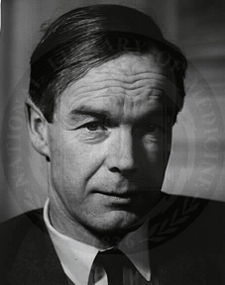Alan Lloyd Hodgkin
| Sir Alan Lloyd Hodgkin | |
 |
|
| Born | 5 February 1914 Banbury, Oxfordshire, England |
|---|---|
| Died | 20 December 1998 (aged 84) Cambridge, Cambridgeshire, England |
| Nationality | United Kingdom |
| Notable awards | Nobel Prize in Physiology or Medicine (1963) |
Sir Alan Lloyd Hodgkin, OM, KBE, FRS (5 February 1914, Banbury, Oxfordshire, England[1] – 20 December 1998 Cambridge[2]) was a British physiologist and biophysicist, who won the 1963 Nobel Prize in Physiology or Medicine.
Contents |
Early life
Hodgkin was educated at The Downs School (Malvern), Gresham's School, Holt, and Trinity College, Cambridge.[3]
Career
During the Second World War, he volunteered to work on Aviation Medicine at Farnborough and was subsequently transferred to the Telecommunications Research Establishment (TRE) where he worked on the development of centimetric radar, including the design of the Village Inn airborne gun-laying system.
With Andrew Fielding Huxley, Hodgkin worked on experimental measurements and developed an action potential theory representing one of the earliest applications of a technique of electrophysiology, known as the "voltage clamp". The second critical element of their research was the so-called giant axon of Atlantic squid (Loligo pealei), which enabled them to record ionic currents as they would not have been able to do in almost any other neuron, such cells being too small to study by the techniques of the time. The experiments took place at the University of Cambridge beginning in 1935 with frog sciatic nerve and continuing into the 1940s, after interruption by World War II. Hodgkin and Huxley published their theory in 1952.
In 1963, with Huxley, he won the Nobel Prize in Physiology or Medicine for their work on the basis of nerve "action potentials," the electrical impulses which enable the activity of an organism to be coordinated by a central nervous system. Hodgkin and Huxley shared the prize that year with John Carew Eccles, who was cited for his research on synapses. Hodgkin and Huxley's findings led them to hypothesize ion channels, which were confirmed only decades later. Confirmation of ion channels came with the development of the patch clamp, which led to a Nobel prize in 1991 for Erwin Neher and Bert Sakmann.
From 1978 to 1984, Hodgkin was Master of Trinity College, Cambridge.
Honours
Hodgkin was knighted in 1972 and appointed to the Order of Merit in 1973. From 1970 to 1975 he was President of the Royal Society.
See also
- Hodgkin-Huxley model
References
- ↑ GRO Register of Births: MAR 1914 3a 2167 BANBURY - Alan L. Hodgkin, mmn = Wilson
- ↑ GRO Register of Deaths: DEC 1998 B43C 32 CAMBRIDGE - Alan Lloyd Hodgkin, DoB = 5 Feb 1914, aged 84
- ↑ Benson, S. G. G., Crossley Evans, Martin, I Will Plant Me a Tree: an Illustrated History of Gresham's School (James & James, London, 2002) ISBN 0-907383-92-0
- The Master of Trinity at Trinity College, Cambridge
- Nobel biography of Hodgkin
- BBC obituary
- Speech at Nobel banquet, 1963
- Action Potential Paper
| Honorary titles | ||
|---|---|---|
| Preceded by The Lord Butler of Saffron Walden |
Master of Trinity College, Cambridge 1978–1984 |
Succeeded by Sir Andrew Huxley |
| Preceded by The Lord Adrian |
Chancellor of the University of Leicester 1971–1984 |
Succeeded by Sir George Porter |
|
||||||||
|
|||||||||||
| Persondata | |
|---|---|
| NAME | Hodgkin, Alan Lloyd |
| ALTERNATIVE NAMES | |
| SHORT DESCRIPTION | physiologist and biophysicist |
| DATE OF BIRTH | 1914-02-05 |
| PLACE OF BIRTH | Banbury, Oxfordshire, England |
| DATE OF DEATH | 1998-12-20 |
| PLACE OF DEATH | |